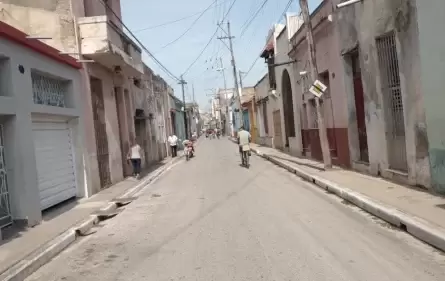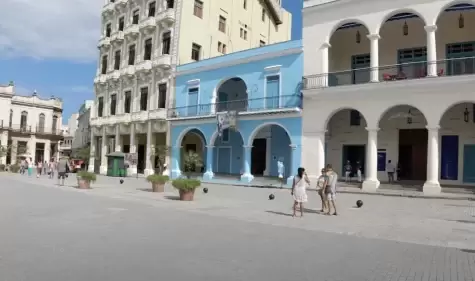
Camagüey Webcam – Cuba | Real Time Live Video
September 27, 2022
Please enjoy your virtual travel via this Camagüey Webcam. Camagüey is the nation’s third largest city, located in central Cuba. Keep an eye on the current weather conditions. Take a look at the 7-day forecast above, which includes precipitation and the temperature highs and lows. Below is the weather radar with interactive map, allowing you to zoom and pan to get unmatched weather details.

Live Webcam Santiago de Cuba, Cuba
September 27, 2022
Get a live look at this Santiago de Cuba Live Webcam. Santiago de Cuba is a city that is the capitol of the province of the same name. It is the second largest city in all of Cuba. Keep an eye on the current weather conditions. Take a look at the 7-day forecast above, which includes precipitation and the temperature highs and lows. Below is the weather radar with interactive map, allowing you to zoom and pan to get unmatched weather details.

Havana Cuba Webcam
September 25, 2022
Take a look at this panoramic view of this Havana Cuba Webcam. Havana is the capital of Cuba, as well as the country’s main port and commercial center. Havana is located in La Habana Province, in the northwestern side of Cuba.
Live Webcams in Cuba
Watch all live HD webcams located in the island country of Cuba. Tourism is a booming industry generating about 5 million visitors annually and is one of the main sources of revenue for the island. With its favorable climate, beaches, colonial architecture and distinct cultural history.
Cuba is famous for its cigars, its rum made from sugar cane, its ladies, Salsa and other Cuban dance styles, Fidel Castro and Che Guevara, 1950s-era cars, Spanish-colonial architecture, Cuban National Ballet, Buena Vista Social Club and Guantanamo Bay.
Cuba is a beautiful island in the Caribbean Sea. It is known for its warm weather, friendly people, and rich culture. When you explore Cuba, you can see many colorful buildings and old cars from the 1950s. The streets are lively with music and dance. Many visitors enjoy walking in cities like Havana, where you can feel the energy of the people. The beaches in Cuba are also very lovely, with soft sand and clear blue water, making it a perfect place to relax.
The food in Cuba is delicious and unique. You can try dishes like Ropa Vieja, which is shredded beef cooked with spices. Another popular dish is Moros y Cristianos, which is rice cooked with black beans. There are many street vendors selling fresh fruit, snacks, and sweets. When you explore Cuba, you can enjoy tasting the local cuisine and discovering new flavors.
Cuba is also famous for its music and dancing. Styles like salsa, son, and mambo originated from this island. When you explore Cuba, you might see people dancing in the streets or hear live music playing at local cafes. You can even join a dance lesson to learn some moves. Music brings people together and reflects the spirit of the country.
Stats & Information
Population: 11.2 milion
Capital: Havana
Major cities: Havana, Santiago de Cuba, Camagüey, Holguín, Guantánamo, Santa Clara, Arroyo Naranjo, Las Tunas, Bayamo, Pinar del Río, Cienfuegos, San Miguel del Padrón
Climate: subtropical weather with two discrete seasons.
Major Airports: Jose Marti International Airport
Main attractions & Things To Do
- beaches
- Old Havana (Habana Vieja)
- Varadero
- Trinidad
- Guardalavaca
- Playa Paraíso
- Cayo Largo del Sur
- Cayo Coco
- Parque Nacional Viñales (Valle de Viñales)
- Baracoa
- The Malecon
- Che Guevara Mausoleum
- Museo Nacional de Bellas Artes
- Castillo de San Pedro del Morro
- Peninsula de Zapata (Ciénaga de Zapata)
- El Nicho Waterfalls
- Parque Historico Military
- Plaza de la Revolucion (Jose Marti Memorial)
Weather & Climate
Cuba has a warm, tropical climate that makes it a nice place to visit. The weather is usually sunny and hot, especially in the summer. There are two main seasons: the dry season, which is from November to April, and the rainy season, from May to October. During the rainy season, Cuba can experience storms and hurricanes. The average temperature is around 80°F (27°C) all year. This warm weather supports many plants and animals, making Cuba a beautiful island in the Caribbean. The Cuba live webcams allow you to stay up to date with weather conditions.
History
Cuba has a rich and varied history that dates back to the arrival of Christopher Columbus in 1492. He was the first European to land on the island, claiming it for Spain. Soon after, Spanish settlers began to establish colonies, leading to the exploitation of Cuban resources and indigenous populations. The arrival of enslaved Africans changed the island’s demographics and culture significantly. As the sugar industry grew, Cuba became an essential part of the transatlantic trade, shaping its economy and society.
In the 19th century, Cuba experienced a series of struggles for independence. The first significant war for freedom began in 1868, led by figures like Carlos Manuel de Céspedes. Despite facing fierce opposition from Spain, Cuba saw a rise in nationalistic sentiments. By the end of the century, the Cuban War of Independence was underway, which caught the attention of the United States. Their involvement culminated in the Spanish-American War of 1898, leading to Spain’s defeat and Cuba’s temporary independence, although the U.S. retained considerable influence over the island.
The early 20th century brought political instability and economic challenges for Cuba. Various leaders came to power, but corruption and dictatorship were common. In 1959, Fidel Castro led a successful revolution, overthrowing the government and establishing a socialist state. This event marked a new chapter in Cuban history, as it faced economic embargoes and political isolation, particularly from the United States. Over the decades, Cuba has worked to carve out its path, preserving its unique culture and identity while navigating the complexities of global politics.